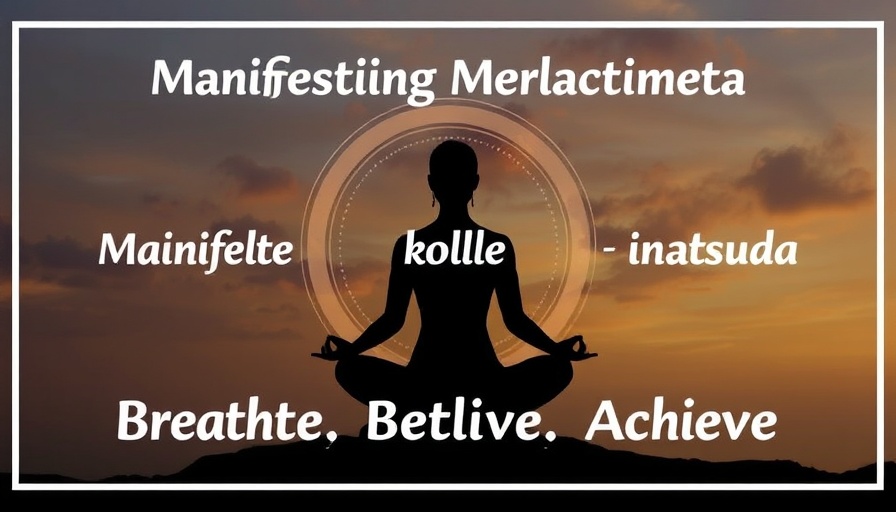
Embrace the Power of Manifestation Through Mindfulness
In our fast-paced world, many of us grapple with anxiety and stress, which can lead to feelings of overwhelm and hopelessness. For those suffering from anxiety disorders or mental health issues, finding effective coping mechanisms is crucial. The innovative method of manifesting meditation—a synthesis of breathing, belief, and achievement—invites individuals to explore their inner potential and transform their emotional landscape.
Understanding the Basics of Manifesting Meditation
At its core, manifesting meditation combines traditional meditation techniques with focused intention-setting. This practice encourages individuals to concentrate on their desires while fostering a sense of calm through mindful breathing exercises. By anchoring our thoughts in positivity while managing anxiety symptoms, we can create an environment that invites change and personal growth. The key is consistency and belief; the act of visualizing positive outcomes can significantly impact mental health and overall well-being.
Why Breathing Matters in Managing Anxiety Symptoms
Breathing is not just a physiological process; it is also a central aspect of relaxation techniques. For those struggling with generalized anxiety disorder, panic attacks, or social anxiety, controlled breathing can drastically improve emotional responses. Research indicates that practitioners of mindfulness and meditation often report significant declines in anxiety levels and increases in self-awareness. By being intentional about our breathing—inhaling deeply, holding for a moment, and exhaling slowly—we can activate our body's relaxation response, reducing feelings of stress and promoting mindfulness.
The Role of Belief in Overcoming Mental Health Challenges
Belief plays a transformative role in mental health. It underpins self-care practices and personal resilience. When embracing the principles of manifesting meditation, practitioners must cultivate faith in their abilities to achieve their aspirations. This belief is not just about positive affirmations; it requires action and a commitment to self-improvement. For individuals and families navigating issues like depression, phobias, or the aftermath of trauma, fostering a sense of hope becomes a protective factor against further mental health struggles.
Achieve Your Goals: Practical Steps to Manifesting
So how can you begin your journey toward manifesting meditation? Start with these actionable insights:
- Create a Space: Dedicate a quiet area in your home for meditation. Incorporate calming elements like plants, soft lighting, or soothing music to promote relaxation.
- Set Your Intentions: Clearly define what you hope to manifest. Write it down and visualize it during your meditation session.
- Practice Regularly: Consistent practice is essential. Set aside 5-10 minutes daily to focus on your breathing and intentions.
- Incorporate Support Groups: Engage with others who share similar mental health challenges. Support networks enhance resilience and provide an avenue for shared experiences.
- Explore Therapeutic Options: Consider combining manifesting meditation with psychotherapy or counseling for a holistic approach to mental well-being.
Connecting Through Community and Shared Experiences
Manifesting meditation not only fosters individual well-being but also promotes a sense of community. Sharing personal narratives in support groups or with friends can help diminish the stigma around mental health. This communal approach allows individuals to empathize with one another’s struggles, making recovery feel more attainable.
The Way Forward: Mental Health Awareness and Action
In today's climate, especially amidst economic stressors and uncertainties related to the pandemic, mental health awareness is more critical than ever. By advocating for resources like the SADAG helpline and community outreach programs, we can ensure that mental health discussions become normalized. Primarily focusing on prevention strategies and early intervention will empower individuals, families, and communities to live healthier and more fulfilled lives.
Conclusion: Your Path to Resilience Starts Today
Engaging with manifesting meditation can bring profound benefits to your life and mental health. It has the potential to lessen the burden of anxiety disorders, depression, and amidst the chaos of life, remind us of our inherent resilience and strength. Embrace this powerful practice and take control of your journey to well-being. Remember, your path to a fulfilling life starts with a single breath—so breathe, believe, and achieve.
 Add Row
Add Row  Add
Add 




Write A Comment